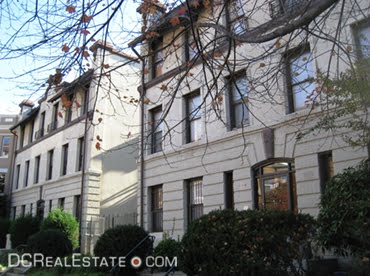 At 3 PM today, the Montgomery County Planning Board will decide the fate of a collection of duplex and three-story apartment buildings, located on 22 acres of land at the intersection of East-West Highway and 16th Street in Silver Spring, MD. Home Properties of New York, the owner of the Falklands Apartments, has submitted an application to raze some of the buildings, created in the wake of FDR's New Deal programs, despite their placement on a list of historic "potentials" - a catalog of possibly-vintage properties that the county has protected from destruction until officially determined as being devoid of historic value.
At 3 PM today, the Montgomery County Planning Board will decide the fate of a collection of duplex and three-story apartment buildings, located on 22 acres of land at the intersection of East-West Highway and 16th Street in Silver Spring, MD. Home Properties of New York, the owner of the Falklands Apartments, has submitted an application to raze some of the buildings, created in the wake of FDR's New Deal programs, despite their placement on a list of historic "potentials" - a catalog of possibly-vintage properties that the county has protected from destruction until officially determined as being devoid of historic value.Home Properties is attempting to demolish a third of the apartments on the northern half of the site in order to clear the way for a collection of new buildings: a mixed-use set of apartments and stores which will create 1,059 residential units, a 50,000 s.f. grocery store and 15,000 s.f. of retail. Demolition of the existing housing needs to be cleared by the Historic Preservation Commission.
The site has been under historic evaluation since 1985; at that time Falkland failed to satisfy the requirements of historic designation. Unfortunately for Home Properties, the real estate may boast some intrinsic historical value. Aside from being the first garden apartment complex in Montgomery County, the Falkland Apartments were inaugurated by Eleanor Roosevelt in 1937. The Falkland residences were created to satiate the rapidly escalating swarms of people that were moving into the area following the inception of FDR's New Deal programs; Montgomery County's population grew by more than 70% during this period.
The apartment complex was reevaluated again on August 15 of this year, when the commission concluded that further investigation was required; on the whole, the site was deemed "eligible" for classification on the Master Plan for Historic Preservation. Home Properties has argued that the apartments are not suited for designation because of the failed 1985 valuation. Members of the community have opinions to the contrary; the Planning Board received more than a dozen letters pleading for historic designation of the site - there were no letters pleading for a mixed-use development. County Planners have recommended that the Planning Board consider all three of the parcels that make up the Falkland Apartment buildings as eligible for historic designation, leaving an all or nothing choice to the County Council.




























